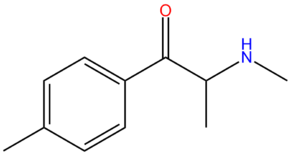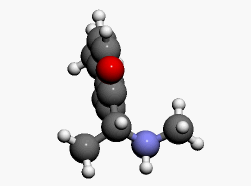Mephedrone
 |
This article is a stub. As such, it may contain incomplete or wrong information. You can help by expanding it. |
Mephedrone, also known as 4-methylmethcathinone (4-MMC) or 4-methylephedrone, is a synthetic stimulant drug of the amphetamine and cathinone classes. Slang names include drone,[1] M-CAT,[2] and meow meow.[3] It is chemically similar to the cathinone compounds found in the khat plant of eastern Africa. It comes in the form of tablets or a powder, which users can swallow, snort, inject or insert rectally producing effects which are somewhat similar to that MDMA, amphetamine and cocaine.
Mephedrone was first synthesised in 1929, but did not become widely known until it was rediscovered in 2003. By 2007, mephedrone was reported to be available for sale on the internet, by 2008 law enforcement agencies had become aware of the compound, and by 2010, it had been reported in most of Europe, becoming particularly prevalent in the United Kingdom.
Chemistry
Pharmacology
Given its chemical structure, mephedrone is likely to act as a releasing agent and a reuptake inhibitor for monoamine neurotransmitters such as dopamine, serotonin and noradrenaline.[4]
Several articles published near the end of 2011 examined the effects of mephedrone in the brains of rats, as well as examining the reinforcing potential of mephedrone. Dopamine and serotonin were collected using microdialysis, and increases in dopamine and serotonin were measured. Mephedrone administration caused about a 500% increase in dopamine, and about a 950% increase in serotonin. They reached their peak concentrations at 40 minutes and 20 minutes and returned to baseline by 120 minutes after injection.
Analysis of the ratio for dopamine and serotonin indicated mephedrone was preferentially a serotonin releaser, with a ratio of 1.22:1 (serotonin vs. dopamine). Additionally, half-lives for the decrease in DA and 5-HT were calculated and found to have decay rates of 24.5 minutes and 25.5 minutes. These findings show mephedrone induces a massive increase in both dopamine and serotonin, combined with rapid clearance. This increase in neurotransmitters provides an explanation for the euphoric and stimulating subjective effects induced by this experience. The rapid rise and subsequent fall of dopamine levels could also explain some of the addictive properties mephedrone displays in some users.[5][6]
Subjective effects
The physical effects of mephedrone can be broken down into five components all of which progressively intensify proportional to dosage. These are described below and generally include:
- Spontaneous tactile sensations - the body high of mephedrone can be described as a moderate to extreme euphoric tingling sensation that encompasses the entire body. It is capable of becoming overwhelmingly pleasurable at higher dosages. This sensation maintains a consistent presence that steadily rises with the onset and hits its limit once the peak has been reached.
- Enhancement of touch
- Stimulation - in terms of its effects on the users physical energy levels, mephedrone is commonly considered to be extremely stimulating and energetic. This encourages activities such as running, climbing and dancing in a way that makes mephedrone a popular choice for musical events such as festivals and raves. The particular style of stimulation which mephedrone presents can be described as forced. This means that at higher dosages it becomes difficult or impossible to keep still, as jaw clenching and involuntarily bodily shakes and vibrations become present, resulting in an extreme unsteadiness of the hands and a general lack of motor control.
- Vibrating vision - a person's eyeballs may even begin to spontaneously wiggle back and forth in a rapid motion, causing vision to become blurry and temporarily out of focus; a condition known as nystagmus.
- Dehydration - dry mouth and dehydration are a universal experience with MDMA and a product of increased heart rate and an extreme motivation to engage in strenuous physical activities that it induces. While it is important to avoid becoming dehydrated, especially when out dancing in a hot environment, there have been a number of users suffering from water intoxication through over drinking so it is advised that users simply sip at water and never over drink.
- Difficulty urinating - higher doses of MDMA result in an overall difficulty when it comes to urination, an effect that is completely temporary and harmless, due to MDMA’s promotion of the release of anti-diuretic hormone (ADH). ADH is responsible for regulating urination. This effect can be lessened by simply relaxing but can be significantly relieved by placing a hot flannel over the genitals to warm them up and encourage blood flow.
The cognitive effects of MDMA can be broken down into ten components all of which progressively intensify proportional to dosage. The general head space of MDMA is described by many as one of extreme mental stimulation, feelings of love or empathy and powerful euphoria. It contains a large number of typical Psychedelic, Entactogenic and Stimulant cognitive effects.
The most prominent of these cognitive effects generally include,
- Euphoria - strong emotional euphoria and feelings of happiness are present within MDMA and likely a direct result of serotonin and dopamine release.
- Acceleration of thought
- Increased empathy, love and sociability - this particular effect is the more pronounced, powerful and therapeutic with mephedrone than any other known substance. It is the most obvious and noticeable effect within any mephedrone experience and dominates the head space. With time and repeated use however, this effect becomes severely diminished as the perspective it instils becomes fully grounded and already in place, making people feel merely stimulated and euphoric with no new found urges to communicate with others. Some users report that mephedrone 'loses its magic' with as few as 10 experiences, while others have reported hundreds of uses before the empathic qualities disappear. This does not appear to be true for all users, however, with many users reporting that they have not experienced any decrease in quality of the experience despite dozens or even hundreds of uses.
- Time distortion - strong feelings of time compression are common within mephedrone and speed up the experience of time quite noticeable.
Toxicity and Harm Potential
Almost nothing is known about the long-term effects of mephedrone due to its short history of its use.[7] Along side of this, the median lethal dosage remains unknown and unstudied.[8]
Despite similarities to known neurotoxins such as methamphetamine and other cathinone derivatives, mephedrone does not appear to produce neurotoxic effects in the dopamine system of mice.[9]
Tolerance and addiction potential
Tolerance develops rapidly in mephedrone abuse, so periods of extended use require increasing doses of the drug in order to achieve the same effect. Addiction is a serious risk with heavy recreational mephedrone use, but is unlikely to arise from occasional and responsible usage.
Interactions
Mephedrone should not be used in combination with other stimulants as it could potentially increase ones heart rate and blood pressure to dangerous levels.
Legal issues
- European Union (EU): In October 2010, a European Union commission called for an EU-wide ban of mephedrone.[10]
- Australia: Mephedrone has been added to the Australian federal drug watch list and is now considered illegal if intended for human consumption.
- Belgium: Mephedrone was banned on Apr 29 2010, by making it a regulated drug requiring the approval of the Ministry of Human Health to import, sell, or possess.
- Brazil: Mephedrone was added to the list of Scheduled drugs (class F2), making it illegal to possess, sell, or manufacture without a license as of August, 2011.[11]
- China: Mephedrone was made a Category I psychotropic substance, illegal to sell, buy, import, export, and manufacture mephedrone as of September 2010.
- Denmark: Denmark's Minister for Health and Prevention Jakob Axel Nielsen banned "mephedrone", "flephedrone" and ethylcathinone on Dec 18, 2008. As of July 1, 2012, Denmark also created a type of Analogue law that would include cathinones like mephedrone[12]
- Finland: Through the Medicines Act, mephedrone is classified as a "medicinal product", making it illegal to manufacture, import, possess, sell, or transfer it without a prescription.
- France: French Ministry of Health decided in early June 2010 to add mephedrone to the list of illicit substances in the "Journal Officiel du 11 juin 2010".[13]
- Germany (Deutschland): mephedrone has been added to Anlage I starting Jan 22, 2010 and will then be controlled in Germany.[14]
- Israel: In December 2007, mephedrone was added to Israel's list of controlled substances, making it illegal to buy, sell, or possess. [15]
- Netherlands: In March, 2010, the Dutch Ministry of Health and the Medicines Authority IGZ informed the Ministry of Justice that they now consider Mephedrone an unregulated medicine and sales and distribution of it are now prohibited.
- Norway: The "Derivatbestemmelsen" is an Analog Act-type law in Norway that controls mephedrone, Bk-MBDB, Bromo-Dragonfly, 1,4butanediol, GBL, and MBDB.[16]
- Poland: On Aug 25, 2010, mephedrone was added to the list of controlled "psychotropic drugs" in the I-P group.[17]
- Romania: mephedrone was added to Romania's list of controlled substances in February 2010.[18]
- Russia: Mephedrone is classified as List 1 in Russian Federation as if August 2010. This means it is illegal to manufacture, buy, possess, or distribute.[19]
- Slovak Republic: Starting March 1, 2011 mephedrone is controlled in the Slovak Republic. [20]
- Sweden: Classified as a "health hazard" or "hazardous substance" ("hälsofarlig vara") pending further legislation, a ban on mephedrone went into effect on December 15, 2008, making its sale illegal. Use of 4-methylmethcathinone is not explicitly illegal under this regulation.
- United Kingdom: mephedrone is a class B drug, illegal to possess without the proper license or prescription, as of Apr 16, 2010.
- USA: mephedrone is currently in Schedule I in the United States. This means it is illegal to manufacture, buy, possess, or distribute (sell, trade or give) without a DEA license.
See also
References
- ↑ Mephedrone: Chemistry lessons | http://www.telegraph.co.uk/health/7614099/Mephedrone-Chemistry-lessons.html
- ↑ Drugs crackdown hailed a success | http://news.bbc.co.uk/1/hi/scotland/north_east/8555872.stm
- ↑ Mephedrone (4-methylmethcathinone; ‘meow meow’): chemical, pharmacological and clinical issues | http://link.springer.com/article/10.1007%2Fs00213-010-2070-x
- ↑ What should be done about mephedrone? | http://www.ncbi.nlm.nih.gov/pubmed/20332508
- ↑ Mephedrone, compared with MDMA (ecstasy) and amphetamine, rapidly increases both dopamine and 5-HT levels in nucleus accumbens of awake rats | http://www.ncbi.nlm.nih.gov/pmc/articles/PMC3246659/
- ↑ 4-Methylmethcathinone (mephedrone): neuropharmacological effects of a designer stimulant of abuse | http://www.ncbi.nlm.nih.gov/pubmed/21810934?dopt=Abstract
- ↑ Clubbers are 'turning to new legal high mephedrone' | http://www.bbc.co.uk/newsbeat/10004366
- ↑ Mephedrone, new kid for the chop? | http://www.ncbi.nlm.nih.gov/pubmed/20735367
- ↑ Mephedrone, an abused psychoactive component of 'bath salts' and methamphetamine congener, does not cause neurotoxicity to dopamine nerve endings of the striatum | http://www.ncbi.nlm.nih.gov/pubmed/22191803
- ↑ http://europa.eu/rapid/press-release_IP-10-1355_en.htm?locale=en
- ↑ http://www.anvisa.gov.br/hotsite/talidomida/legis/RDC_36_2011.pdf
- ↑ https://www.retsinformation.dk/forms/R0710.aspx?id=140430
- ↑ http://www.sante-sports.gouv.fr/la-mephedrone-classee-comme-stupefiant.html
- ↑ http://www.buzer.de/gesetz/9164/index.htm
- ↑ http://www.jpost.com/Israel/Article.aspx?id=181254
- ↑ legemiddelverket.no
- ↑ http://isap.sejm.gov.pl/DetailsServlet?id=WDU20101430962
- ↑ http://salviadivinorum.ro/noile-substante-intezise/
- ↑ http://gazeta.ru/news/lenta/2010/08/04/n_1529350.shtml
- ↑ http://www.nrsr.sk/Dynamic/Download.aspx?DocID=350863

